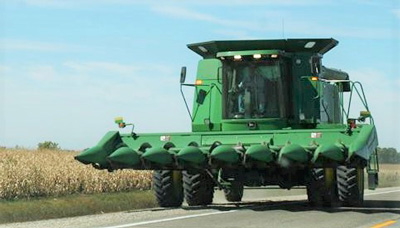With the arrival of autumn, farmers are out harvesting their crops, which means large farm equipment will be on the roadways.

File photo
As farmers move their equipment from field to field, motorists are reminded to exercise caution on the roadways, particularly on county roads. Remember, some farm implements are much wider than the normal vehicle using the roadways and motorists may need to slow down, move over, and perhaps even come to a stop to allow these large pieces of machinery to pass.
Tips for farmers
- Have all lighting and placards on your equipment as required by law.
- When parking equipment along the road while in the field, make certain it is visible at night.
- Avoid traveling on state and U.S. highways during rush hour traffic.
- Wear high visibility or reflective clothing when working so as to be seen by motorists and farm workers.
- Indiana Code 9-21-5-7 requires operators of vehicles being driven at a speed below the posted limit to move over to the right at their first opportunity if three or more vehicles are following to allow those vehicles to safely pass.
Tips for motorists
- Be patient when traveling behind farm equipment; farmers have the same rights as automobile drivers to operate their equipment on the roads.
- When approaching farm equipment from the opposite direction, pull to the right of the traveled portion of the road and allow the equipment to pass.
- Always be cautious when approaching farm equipment parked on the side of the road. Someone may be getting into or out of the equipment or performing maintenance.
- Be especially vigilant in watching for farm equipment on two lane roads, and around dusk when conditions can make the equipment harder to see.
- Also watch for deer activity, especially around dawn and dusk. Deer are naturally more active at this time of year and may be spooked from fields as farmers harvest. Deer versus vehicle crashes tend to increase during the fall.
If you would like to be added to the list to be notified of a deer available after a crash, contact Hamilton County Public Safety Communications. There is no guarantee of the quantity or quality of deer, but a permit must be obtained to possess the deer carcass after a crash. These permits are obtained from a law enforcement officer at the scene of the crash.
